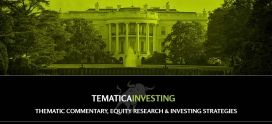Making a Nuanced Move With The Tematica Select Investment List
DOWNLOAD THIS WEEK’S ISSUE
The full content of Tematica Investing is below; however downloading the full issue provides detailed performance tables and charts.Click here to download.
 Over the last week, while many have been watching the Dow Jones Industrial Average flirt with 20,000, the Nasdaq Composite Index continued to climb higher. That led our Connected Society investment theme positions in Facebook (FB), Alphabet (GOOGL) and Amazon (AMZN) higher over the last week.
Over the last week, while many have been watching the Dow Jones Industrial Average flirt with 20,000, the Nasdaq Composite Index continued to climb higher. That led our Connected Society investment theme positions in Facebook (FB), Alphabet (GOOGL) and Amazon (AMZN) higher over the last week.
- Even so, we still have ample room to our respective price targets for each of those positions and our buy rating on all three remains.
Over the last few months, we’ve been talking about the impact of food deflation, which has been confirmed by our Cash-strapped Consumer play that is Costco Wholesale (COST) as well as grocery chain Kroger (KR) and others.
We’ve also called out the inability of restaurants to harness that deflation for their own margins given minimum wage increases and other cost drivers. The latest findings from Fitch Ratings sees restaurant sales slowing this year, and the NPD Group expects traffic will be flat this year, with a 2 percent decline at dine-in restaurants offsetting a 1% increase at quick-service concepts. We expect confirmation to be had this coming earnings season, and if Kona Grill’s (KONA) 4 percent decline in same-store sales for the December quarter is any indication it’s not going to be pretty.
Still, we know that people need to eat and are continuing to shift toward organic and natural foods and other products, which bodes well for our McCormick & Co. (MKC) and United Natural Foods (UNFI) shares. Recent findings from a new poll conducted by Pew Research Center underscore our bullish position. According to the Pew poll, 55 percent of Americans believe that “organic food, particularly organically grown fruits and vegetables, are healthier than conventional.” The same poll also showed a growing distrust of GMO foods and concern over pesticide use.
A different study conducted by the European Parliament’s Independent Research Service, titled “Human health implications of organic food and organic agriculture,” concluded that eating organic food improves early development, reduces pesticide exposure, strengthens the nutritional value of food, and mitigates disease risks.
We do not see this as a short-term fad and point to a recent report from Research and Markets that forecasts the global market for organic food to grow at “a CAGR of over 14 percent during 2016-2021, on account of high demand for organic food.”
- Both MKC and UNFI remain Buys at current levels.
 On the continued strength of Rouge One at the box office and the news that Content is King investment theme company The Walt Disney Co. (DIS) is firming up plans for a streaming ESPN service, our Disney shares moved higher over the last several days.
On the continued strength of Rouge One at the box office and the news that Content is King investment theme company The Walt Disney Co. (DIS) is firming up plans for a streaming ESPN service, our Disney shares moved higher over the last several days.
The same can be said with our CalAmp (CAMP) shares following management’s presentation at the annual Needham Growth Conference that focused on its expanding market opportunities across fleet management, Connected Car and enterprise asset tracking markets.
Adding Nuance Communications (NUAN)
to the Tematica Select List as Voice Goes Big
Last week was the tech world descended upon Las Vegas for CES 2017. The annual trade show kicks off the new year and introduces a number of new consumer gadgets that we’re likely to see — some this year and others in the coming ones.
Among the sea of announcements, there were a number that focused on one aspect of our Disruptive Technology investing theme and that is the area of voice recognition technology. Over the years we’ve seen various incarnations of this technology, most recently with Siri from Apple (AAPL), Cortana from Microsoft (MSFT), Google Assistant from Alphabet (GOOGL) and Alexa from Amazon (AMZN). Each of these has come to the forefront like in products like Amazon Echo and Google Home that house these virtual digital assistants (VDAs), but for now one of the largest consumer-facing markets for voice interface technology has been the smartphone. Coming in 2016, Parks Associates found that nearly 40 percent of all smartphone owners use some sort of voice recognition software such as Siri or Google Now.
In 2016, the up and comer was Amazon as sales of its Echo devices were up 9x year over year this past holiday season and “millions of Alexa devices sold worldwide this year.” If you’re a user of Amazon Echo like we are, then you know that each week more capabilities are being added to the Alexa app such as ordering a pizza from Dominos (DPZ), calling for an Uber, checking sports scores and weather to getting holiday cocktail recipes.
As we entered 2017, Amazon announced that Prime members can voice-order their next meal through Amazon Restaurants on their Alexa-enabled devices including the Amazon Echo and Echo Dot. Once an order is placed, Amazon delivery partners deliver the food in one hour or less. Pretty cool so long as you have Amazon Restaurants operating in and around where you live.
Virtual digital assistants cut across more than just smartphones and devices like Amazon Echo and the recently announced Google Home. According to a new report from Tractica, while smartphone-based consumer VDAs are currently the best-known offerings, virtual assistant technologies are also beginning to penetrate other device types including smart watches, fitness trackers, PCs, smart home systems, and automobiles.
We saw just that at CES 2017 with some landscaping changing announcements for VDAs. Alphabet had several announcements surrounding its Google Home product at CES 2017, including integration into upcoming Hyundai and Chrysler models; and acquiring Limes Audio, which focuses on voice communication systems, and will likely be additive to the company’s Google Home, Hangouts and other products. Microsoft also scored a win for Cortana with Nissan.
While those wins were impressive, the big VDA winner at CES was Amazon as it significantly expanded its Alexa footprint on deals with LG, Dish Network (DISH), Whirlpool (WHR), Huawei and Ford (F). In doing so Amazon has outflanked Alphabet, Microsoft and even Apple in the digital assistant market. To us, that’s another leg to the Amazon stool that offers more support to the share alongside the digital shopping/services, content, and Amazon Web Services businesses. You don’t need to read between the lines to think that we still see big upside to our $975 Amazon price target.
To be fair, Apple originally did not license out its Siri technology and only in June 2016 did it announce that it would open the code behind Siri to third-party developers through an API, giving outside apps the ability to activate from Siri’s voice commands, and potentially endowing Siri with a wide range of new skills and datasets.
Tractica forecasts that unique active consumer VDA users will grow from 390 million in 2015 to 1.8 billion worldwide by the end of 2021. During the same period, unique active enterprise VDA users will rise from 155 million in 2015 to 843 million by 2021. The market intelligence firm forecasts that total VDA revenue will grow from $1.6 billion in 2015 to $15.8 billion in 2021.
An Overlooked Player in the VDA Segment
 The one drawback when it comes to the VDA market is the players mentioned above have large existing businesses, which means their respective VDA businesses, at least in the next few yeas, will have at best modest influence on their overall financial picture. In keeping with our “buy the bullets not the guns,” coming out of CES 2017 we find ourselves looking at speech technology and voice recognition company Nuance Communications (NUAN).
The one drawback when it comes to the VDA market is the players mentioned above have large existing businesses, which means their respective VDA businesses, at least in the next few yeas, will have at best modest influence on their overall financial picture. In keeping with our “buy the bullets not the guns,” coming out of CES 2017 we find ourselves looking at speech technology and voice recognition company Nuance Communications (NUAN).
Nuance’s voice solutions compete in four markets:
- Healthcare (49 percent of revenue): In this business, Nuance supports clinical documentation workflows and electronic medical record (EMR) adoption through flexible offerings, including transcription services, dictation software for the EMR, diagnostics workflow, and mobile applications. Recently Nuance released Dragon Medical Advisor, an AI Assistant for doctors. More than 500,000 clinicians and 10,000 healthcare facilities worldwide use Nuance’s healthcare solutions, which are sold through customers that include Cerner (CERN), Epic, McKesson (MCK), UPMC, Cleveland Clinic, Siemens, and the Mayo Clinic. Over the last few quarters, Nuance has been transitioning this business from a perpetual license business to a software as a service (SAAS) one, but with that shift expected to be largely completed by the second half of 2017 that revenue drag should be eliminated.
- Enterprise (20 percent of revenue): This business segment offers automated intelligent self-service solutions that include speech and artificial intelligence (AI) technologies that reduce or replace human contact center agents with conversational systems, across voice, mobile, web and messaging channels. Think of when you call your bank, broker or even consider using the phone to call for a pizza from Dominos (candidly we’re not sure why you would call given the ease of the Domino’s app that can be used on either your smartphone, Apple TV, or Amazon’s Alexa, but hey that’s us). Representative customers include Avaya, BT, Cisco, DiData, Genesys, Huawei, MoshiMoshi, NICE, Telstra, and Verint. Nuance’s customers include: American Airlines, Amtrak, Bank of America, Barclays, Dominos, Delta, Deutsche Telekom, e*trade, ING Bank, Lloyds Banking Group, T-Mobile, Telefonica, Telstra, and Vodafone.
- Mobile (19 percent of revenue): Here Nuance offers a portfolio of specialized virtual assistants and connected services built on voice recognition, text-to-speech, natural language understanding, dialog, and text input technologies across automotive, device and mobile operator solutions. With regard to automotive in particular, Nuance has announced Daimler, Ford and BMW as customers, and as evidenced at both CES 2017 and the 2017 North American International Auto Show we are nearing the tipping point for the Connected Car, which should bode well for this business segment.
- Imaging (12 percent of revenue): In this division, segment Nuance provides software solutions and expertise that help professionals and organizations to gain optimal control of their document and information processes. Customers and partners include Ricoh, Xerox, HP, Canon, and Samsung. This business has been bumping along at around 11 to 12 percent of revenue the last few years as Nuance has reorganized itself over the last several quarters.
When we step back from Nuance’s business segments and look at the overall market growth for voice recognition technologies, BCC Research sees it growing to $184.9 billion in 2021, up from $90.3 billion in 2015. Breaking these two markets down into Consumer and Enterprise markets, BCC expects the Consumer market to grow to $95.9 billion in 2021 from $54.4 billion in 2016 and the Enterprise market to reach $79.0 billion by 2021 up from $44.0 billion in 2016. Viewed against that larger market, we see ample room for Nuance to expand beyond the $1.9 billion in revenue it generated in 2016.
Over the last few years, after delivering significant revenue growth during 2010-2014, the pace of revenue growth, while positive, has dipped. Part of that is due in part to erosion for the transcription business in the company’s Healthcare business, as well as the shift from a contract business model to a Cloud based one that offers integrated solutions. In 2016, roughly 70 percent of the company’s revenue stream was recurring in nature, up from 65 percent or so in 2015.
What this tells us is the bulk of the revenue shift is largely behind the company. Like a turning tanker, these changes take time, but once they catch momentum they tend to pick up speed and Nuance should see its recurring revenue growth to 70-75 percent of overall revenue during 2017. As investors, we like the nature of a recurring revenue model, given that it affords far greater visibility and shares tend to be rewarded with better multiples given that predictability.
We’ve seen the power of this business shift already at Adobe Systems (ADBE), which now has more than 70 percent of its revenue recurring in nature, up from 19 percent in 2011, and its shares that have climbed to just over $108 from $28 at the end of 2011.
Looking Ahead to 2017 for Nuance
 The growth businesses at Nuance include its automotive, voice biometrics, omni-channel customer care, unified print and scan solutions, Dragon Medical, CDI and diagnostics. Paving the way is the company’s most recent quarterly bookings, which were up 45 percent year on year. Longer-term we expect more applications across the consumer electronics market to develop. As noted above, Whirlpool is working with Amazon and odds are that means before too long we’ll see VDAs built into various appliances across the kitchen and laundry rooms. In our view, that’s just scratching at the surface.
The growth businesses at Nuance include its automotive, voice biometrics, omni-channel customer care, unified print and scan solutions, Dragon Medical, CDI and diagnostics. Paving the way is the company’s most recent quarterly bookings, which were up 45 percent year on year. Longer-term we expect more applications across the consumer electronics market to develop. As noted above, Whirlpool is working with Amazon and odds are that means before too long we’ll see VDAs built into various appliances across the kitchen and laundry rooms. In our view, that’s just scratching at the surface.
The big question circling Nuance is the competitive landscape, particularly the move by Amazon, Alphabet and Apple to open up their application programming interface (API) to third-parties. Just like Rackspace (RACK) specializes in Cloud computing, but thus far has remained unharmed by Amazon’s AWS, Nuance specializes in selling to global brands, health care, and large corporations, which are not likely to utilize Google’s free API for its business needs. As you’ve probably notice with Android, one of the issues with a free API is malware and cyber hacking.
It’s also not lost on us that Alphabet recently acquired Limes Audio to improve its voice recognition capabilities. As anyone who has used Apple’s Siri knows, it’s far from perfect in voice recognition and voice to text. In our view, this means Nuance could be an attractive candidate for a larger player that needs to improve its technology positioning.
What are NUAN shares worth?
In looking over historic multiples, including P/E and Enterprise Value to Revenue, and applying them to consensus 2017 earnings expectations that call for EPS of $1.59 on revenue of just over $2 billion, we see upside to $21 and downside to just under $15.
At the current share price — $15.45 as of market close on 1/10/17 — NUAN shares are trading at under 10x expected 2017 earnings of $1.59 per share. We certainly like that risk-to-reward trade-off in NUAN shares at a time when voice technology is expanding its market size across the device, automotive and Internet of Things markets.
Bottomline on Nuance Communications (NUAN)
- We’re adding NUAN shares to the Tematica Select list with a price target of $21.
- Because this is a new position, we are holding off with a stop loss recommendation at this time, preferring to use near-term weakness to scale into the position and improve the cost basis.
* We strongly recommend you use the link below to download the full report on Nuance Communications (NUAN), which includes background on our Disruptive Technology thematic as well as financials on NUAN.
DOWNLOAD THIS WEEK’S ISSUE
The full content of Tematica Investing is above; however downloading the full issue provides detailed performance tables and charts. Click here to download.








